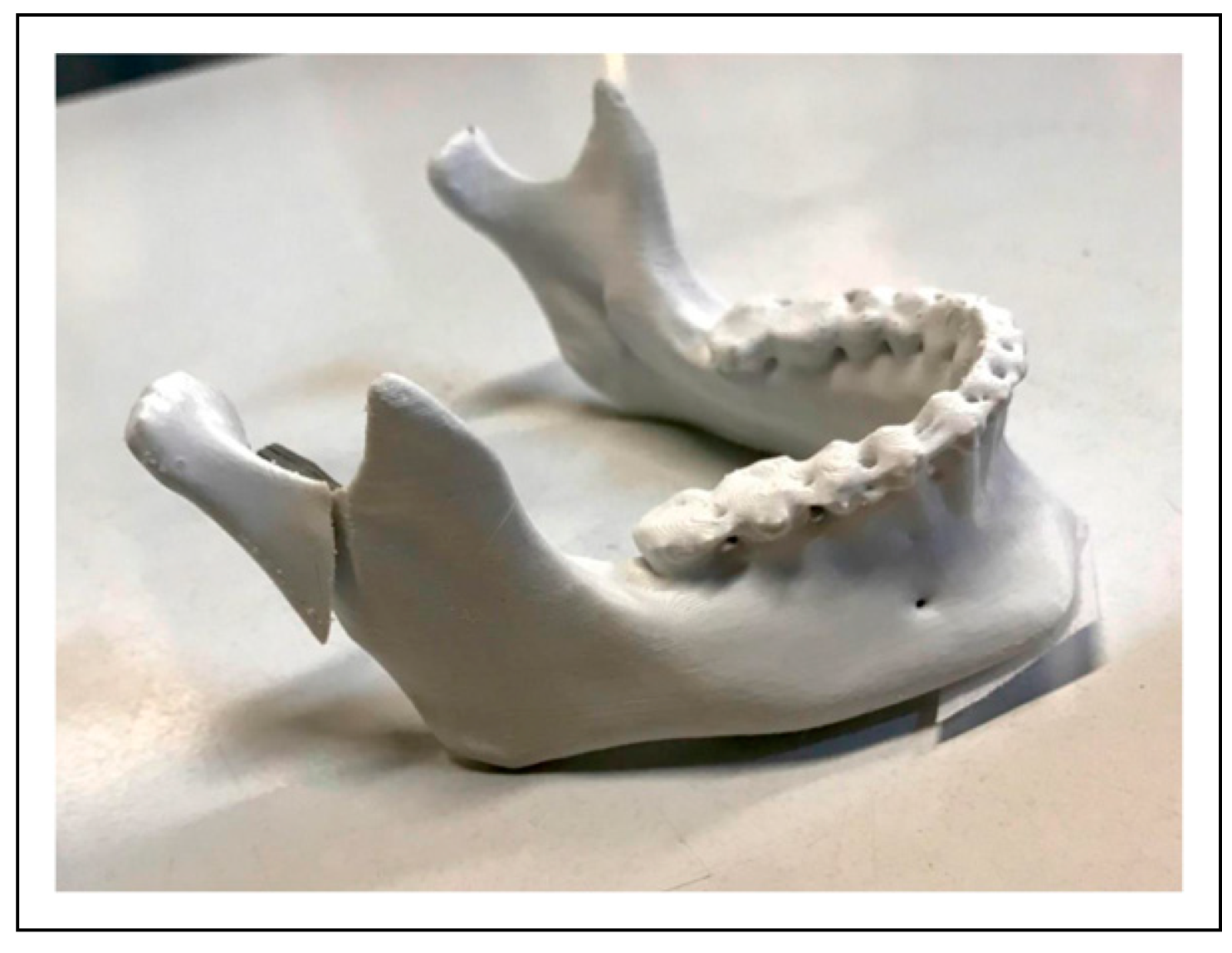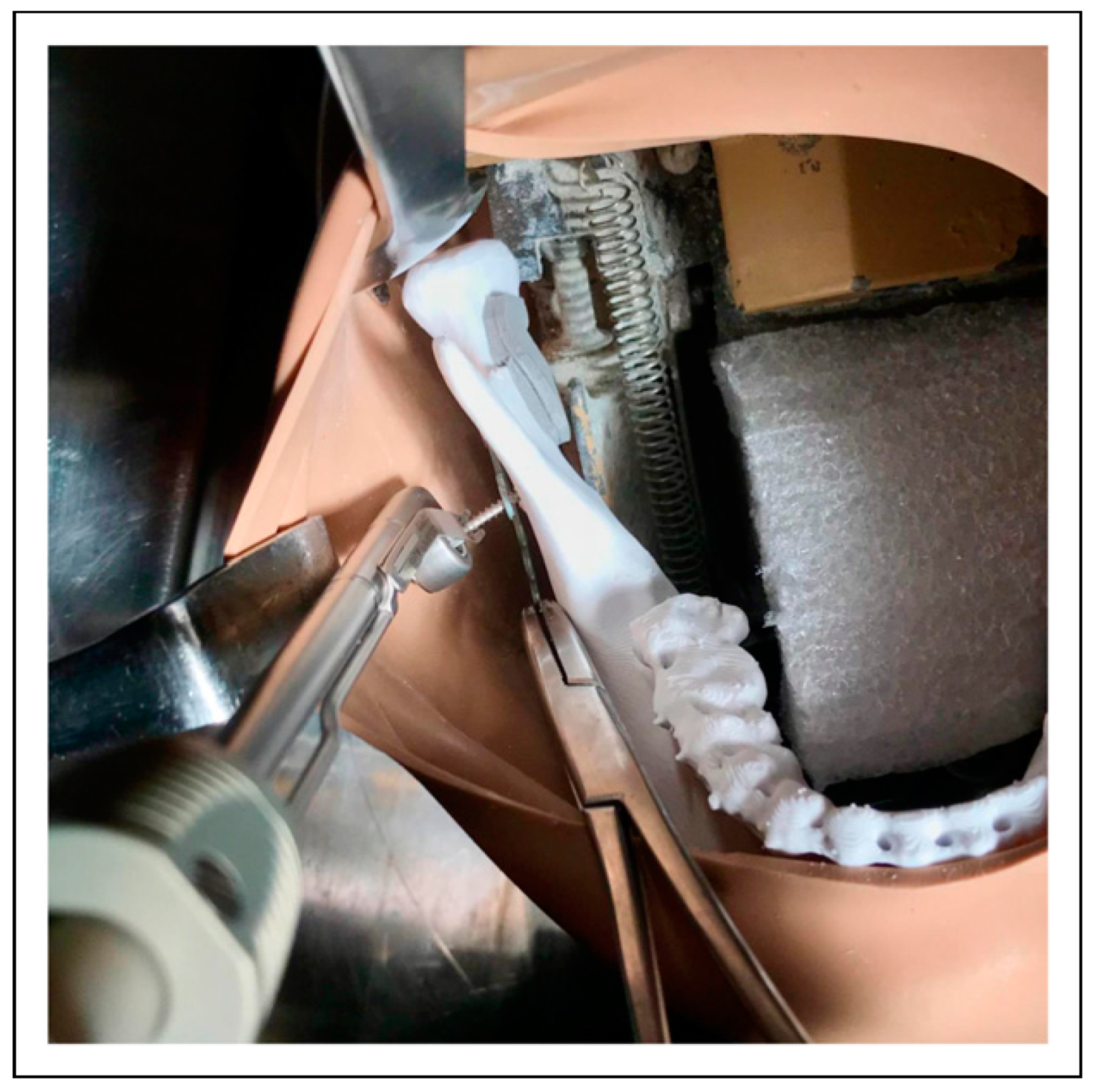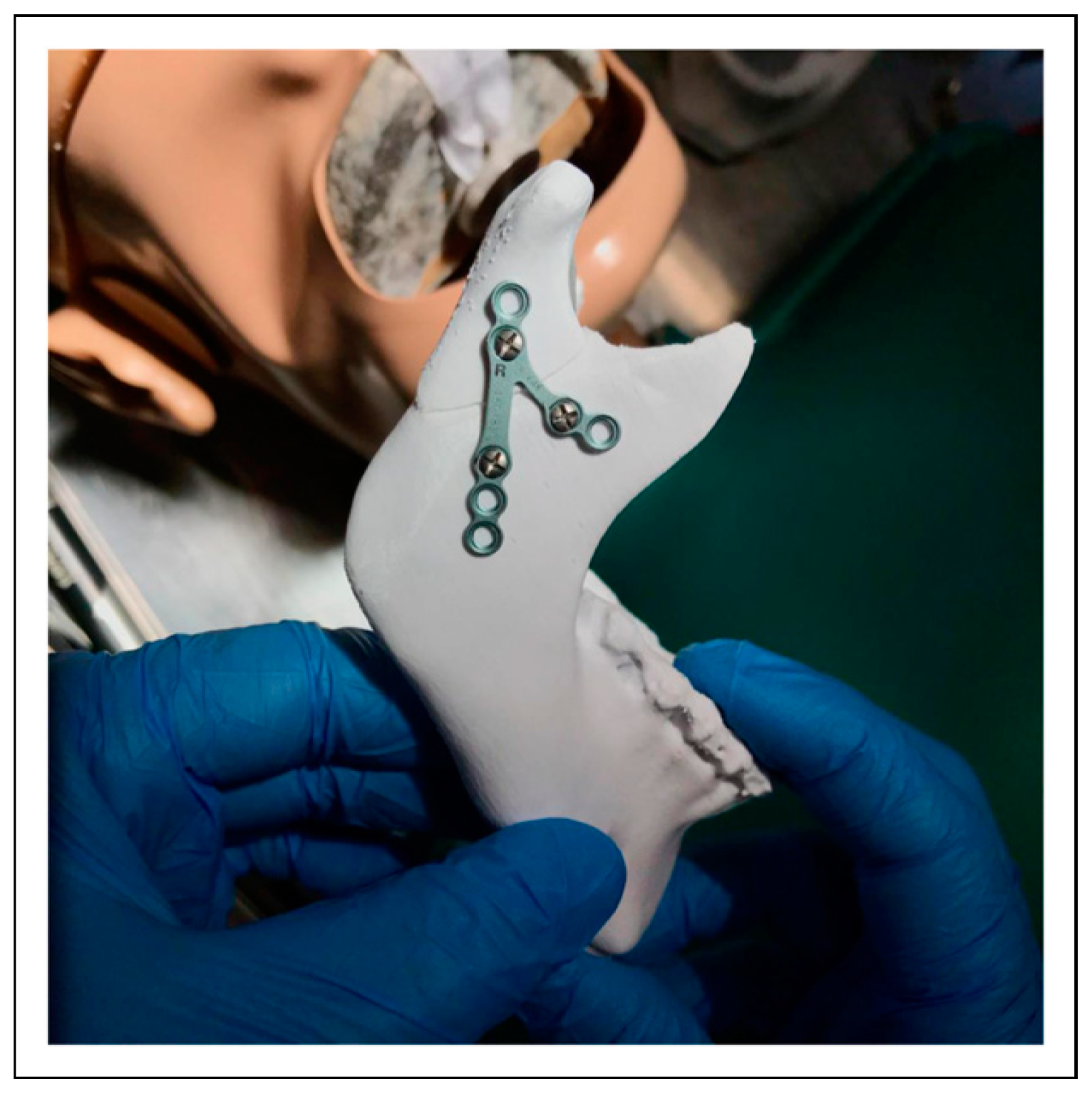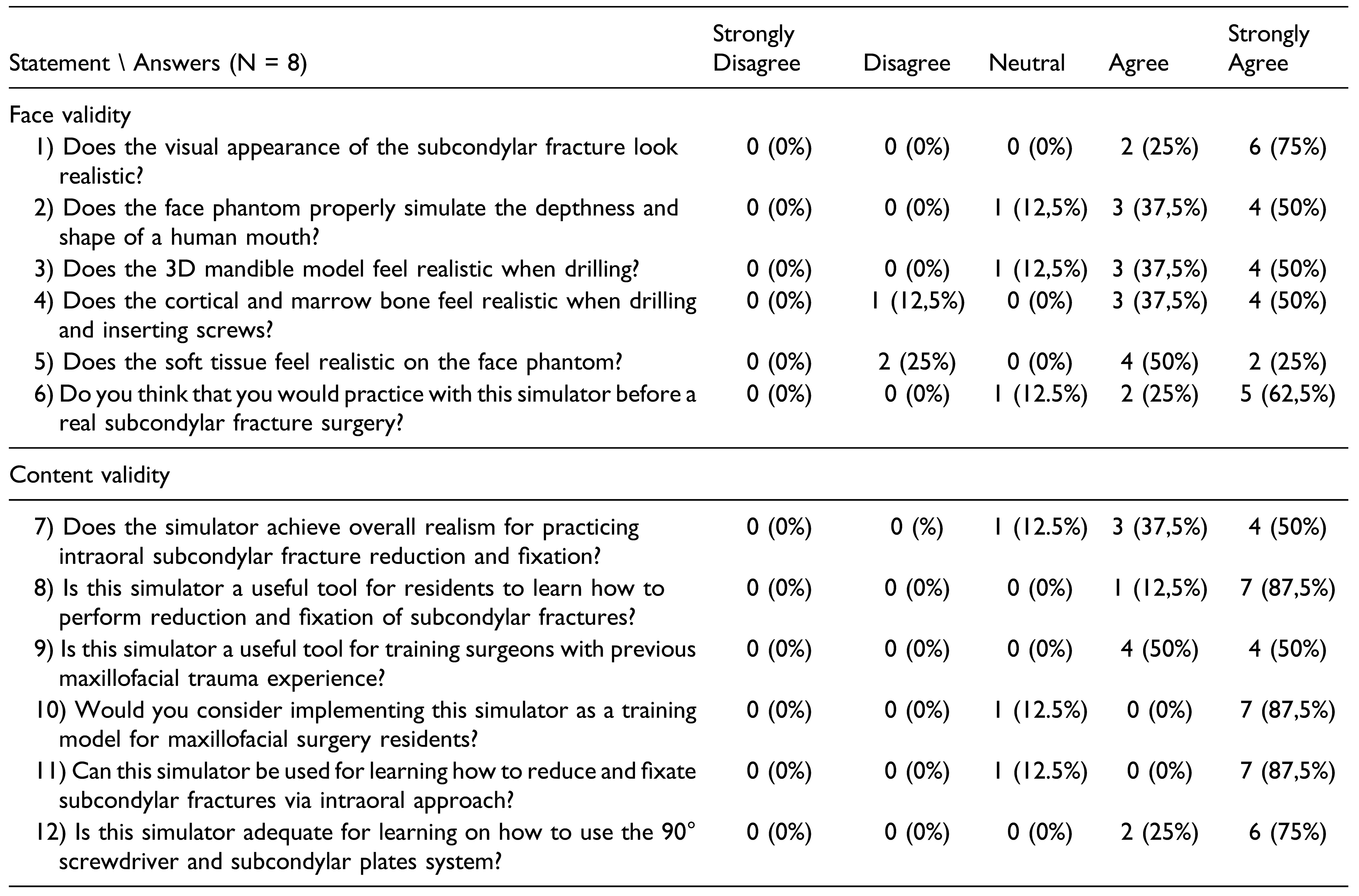Simulating A Subcondylar Mandibular Fracture With Intraoral Open Reduction and Internal Fixation: A Novel Education Tool for Residents
Abstract
Introduction
Materials and Methods
Model Design
Osteosynthesis Systems
Evaluation: Face and Content Validity
Results
Model Development
Face and Content Validation
Face Validation Results
Content Validation Results
Discussion
Conclusions
Funding
Acknowledgments
Declaration of Conflicting Interests
References
- Dayalan, N.; Kumari, B.; Khanna, S.; et al. Is open reduction and internal fixation sacrosanct in the management of subcondylar fractures: A comparative study. J Pharm BioAllied Sci. 2021, 13, S1633–S1636. [Google Scholar] [CrossRef] [PubMed]
- Ellis, E.; Throckmorton, G.S. Treatment of mandibular condylar process fractures: Biological considerations. J Oral Maxillofac Surg. 2005, 63, 115–134. [Google Scholar] [CrossRef]
- Singh, V.; Bhagol, A.; Goel, M.; Kumar, I.; Verma, A. Outcomes of open versus closed treatment of mandibular subcondylar fractures: A prospective randomized study. J Oral Maxillofac Surg. 2010, 68, 1304–1309. [Google Scholar] [CrossRef]
- Hackenberg, B.; Lee, C.; Caterson, E.J. Management of subcondylar mandible fractures in the adult patient. J Craniofac Surg. 2014, 25, 166–171. [Google Scholar] [CrossRef] [PubMed]
- Jacobo, O.M.; Giachero, V.E.; Hartwig, D.K.; Mantrana, G.A. Threedimensional printing modeling: Application in maxillofacial and hand fractures and resident training. Eur J Plast Surg. 2018, 41, 137–146. [Google Scholar] [CrossRef]
- Coffey-Zern, S.; Calvi, R.M.; Vorrasi, J.S.; Meara, D.J. Incorporating simulation into oral and maxillofacial surgery residency education and training: Christiana care’s method. J Oral Maxillofac Surg. 2015, 73, 1244–1245. [Google Scholar] [CrossRef]
- Milburn, J.A.; Khera, G.; Hornby, S.T.; Malone, P.S.C.; Fitzgerald, J.E.F. Introduction, availability and role of simulation in surgical education and training: Review of current evidence and recommendations from the association of surgeons in training. Int J Surg. 2012, 10, 393–398. [Google Scholar] [CrossRef]
- Zargaran, A.; Hirniak, J.; Zargaran, D. Oral and maxillofacial surgical simulation: Efficacy for medical students. Br J Oral Maxillofac Surg. 2020, 58, 1251–1254. [Google Scholar] [CrossRef]
- Meara, D.J.; Zern, S.C. Simulation in craniomaxillofacial training. Curr Opin Otolaryngol Head Neck Surg. 2016, 24, 376–380. [Google Scholar] [CrossRef]
- Christophel, J.J.; Park, S.S.; Nogan, S.J.; Essig, G.F. A facial trauma simulation course for evaluation and treatment of facial fractures. JAMA Facial Plastic Surgery. 2017, 19, 464–467. [Google Scholar] [CrossRef][Green Version]
- Ahmed, N.; McVicar, I.H.; Mitchell, D.A. Simulation-based training in maxillofacial surgery: Are we going to be left behind? Br J Oral Maxillofac Surg 2019, 57, 67–71. [Google Scholar] [CrossRef]
- Shah, S.; Aydin, A.; Fisher, R.; Ahmed, K.; Froghi, S.; Dasgupta, P. Current status of simulation-based training tools in general surgery: A systematic review. International Journal of Surgery Open. 2021, 38, 100427. [Google Scholar] [CrossRef]
- Skertich, N.J.; Schimpke, S.W.; Lee, T.; et al. Pediatric surgery simulation-based training for the general surgery resident. J Surg Res. 2021, 258, 339–344. [Google Scholar] [CrossRef]
- Monje Gil, F.; Hernandez Vila, C.; Moyano Cuevas, J.L.; Lyra, M.; Pagador, J.B.; Sanchez Margallo, F.M. Validation of a simulator for temporomandibular joint arthroscopy. Int J Oral Maxillofac Surg. 2016, 45, 836–841. [Google Scholar] [CrossRef]
- Buckley, C.E.; Kavanagh, D.O.; Traynor, O.; Neary, P.C. Is the skillset obtained in surgical simulation transferable to the operating theatre? Am J Surg. 2014, 207, 146–157. [Google Scholar] [CrossRef]
- Werz, S.M.; Zeichner, S.J.; Berg, B.I.; Zeilhofer, H.F.; Thieringer, F. 3D printed surgical simulation models as educational tool by maxillofacial surgeons. Eur J Dent Educ. 2018, 22, e500–e505. [Google Scholar] [CrossRef] [PubMed]
- Elledge, R.; Speculand, B.; Green, J.; Attard, A. Training in surgery of the temporomandibular joint: Perceptions of trainees in oral and maxillofacial surgery in the United Kingdom. Br J Oral Maxillofac Surg. 2016, 54, 941–945. [Google Scholar] [CrossRef]
- Bertin, H.; Huon, J.F.; Praud, M.; et al. Bilateral sagittal split osteotomy training on mandibular 3-dimensional printed models for maxillofacial surgical residents. Br J Oral Maxillofac Surg. 2020, 58, 953–958. [Google Scholar] [CrossRef]
- Farnworth, L.R.; Lemay, D.E.; Wooldridge, T. A comparison of operative times in arthroscopic ACL reconstruction between orthopaedic faculty and residents: the financial impact of orthopaedic surgical training in the operating room. Iowa Orthop J. 2001, 21, 31–35. [Google Scholar]
- Deutsch, E.S.; Wiet, G.J.; Seidman, M.; et al. Simulation activity in otolaryngology residencies. Otolaryngol Head Neck Surg 2015, 153, 193–201. [Google Scholar] [CrossRef]
- Naples, R.; French, J.C.; Han, A.Y.; Lipman, J.M.; Awad, M.M. The impact of simulation training on operative performance in general surgery: Lessons learned from a prospective randomized trial. J Surg Res. 2022, 270, 513–521. [Google Scholar] [CrossRef]
- Navia, A.; Tejos, R.; Canahuate, S.; et al. MicrosimUC: Validation of a low-cost, portable, do-it-yourself microsurgery training kit. J Reconstr Microsurg. 2022, 38, 409–419. [Google Scholar] [CrossRef]



 |
 |
© 2025 by the authors. Published by MDPI on behalf of the AO Foundation. Licensee MDPI, Basel, Switzerland. This article is an open access article distributed under the terms and conditions of the Creative Commons Attribution (CC BY) license (https://creativecommons.org/licenses/by/4.0/).
Share and Cite
Rojas, F.; Tapia, S.; Campolo, A.; Vargas, A.; Ramírez, H.; Benitez, B.K.; Teuber, C. Simulating A Subcondylar Mandibular Fracture With Intraoral Open Reduction and Internal Fixation: A Novel Education Tool for Residents. Craniomaxillofac. Trauma Reconstr. 2023, 16, 275-280. https://doi.org/10.1177/19433875221129673
Rojas F, Tapia S, Campolo A, Vargas A, Ramírez H, Benitez BK, Teuber C. Simulating A Subcondylar Mandibular Fracture With Intraoral Open Reduction and Internal Fixation: A Novel Education Tool for Residents. Craniomaxillofacial Trauma & Reconstruction. 2023; 16(4):275-280. https://doi.org/10.1177/19433875221129673
Chicago/Turabian StyleRojas, Francisco, Sebastian Tapia, Andrés Campolo, Alex Vargas, Hernán Ramírez, Benito K. Benitez, and Cristian Teuber. 2023. "Simulating A Subcondylar Mandibular Fracture With Intraoral Open Reduction and Internal Fixation: A Novel Education Tool for Residents" Craniomaxillofacial Trauma & Reconstruction 16, no. 4: 275-280. https://doi.org/10.1177/19433875221129673
APA StyleRojas, F., Tapia, S., Campolo, A., Vargas, A., Ramírez, H., Benitez, B. K., & Teuber, C. (2023). Simulating A Subcondylar Mandibular Fracture With Intraoral Open Reduction and Internal Fixation: A Novel Education Tool for Residents. Craniomaxillofacial Trauma & Reconstruction, 16(4), 275-280. https://doi.org/10.1177/19433875221129673




